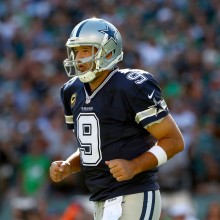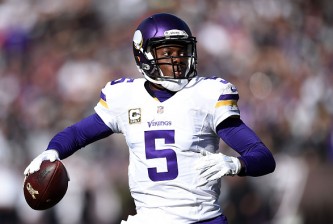Sam Bradford of the St. Louis Rams won't see the field again this season.
The larger question is if he should ever see the field again for the Rams.
Bradford blew out his ACL in Sunday's game against Carolina, and is on injured reserve. After four uneven seasons, it's time for the Rams to evaluate the long-term plan at quarterback. They've never had a winning season with Bradford, who has two years remaining on his rookie contract. He's due $34 million over the next two years, and given his injury, the franchise has to evaluate his future role with the team.
The decision on Bradford should come down to three factors: his health, his development, and finances.
Health
Recovery from ACL injuries has become commonplace. After all, if Adrian Peterson can return to MVP form less than a year after his surgery, there's every reason to expect Bradford to recover from his.
Mobility isn't a factor in Bradford's game to begin with. His career high in rushing is just 127 yards, and he's never broken 3.5 yards a carry. This isn't a Robert Griffin III situation where a significant part of his identity has been compromised.
Bradford should be ready to play come training camp 2014, but that doesn't mean that his overall health isn't a risk. This marks the second significant injury he's had in his four years in the league. A high-ankle sprain in 2011 cost him six games. Combined with his time lost this season, and he'll have missed a quarter of his games as a pro.
These have been largely tough-luck injuries, but keep in mind he missed most of his junior year of college with a shoulder injury as well. That's now three major injuries in five years. At some point, those begin to take a toll on the body and mind of a player.
Everyone wants to see Bradford return and be healthy, but just because ACL injuries no longer threaten careers doesn't mean there aren't serious concerns about the quarterback's durability.
http://youtube.com/watch?v=jgu8wDKSP68
Development
Health worries aside, if Bradford was giving clear signs of becoming an elite quarterback, there wouldn't be any discussion. While it's true the Rams have languished during his tenure, it's hardly fair to pin that all on him. Outside of a dismal 2011, he's fought hard to keep the team around sea level.
The good news for Bradford is that his career does indicate an upward trajectory. His DVOA numbers were strong this year, and show a positive trend. Most of the advanced metrics would rank him squarely in the middle third of quarterbacks for 2013.
His traditional stats were good this year as well. While he's not a high-volume passer, he was on pace for career highs in yards and touchdowns, and he had cut his interception rate as well.
The biggest knock on his game is a painfully low yards per attempt mark. There have been questions about his arm strength ever since his shoulder injury, and he has yet to approach the magic 7.0 mark in YPA. In 2013, he averaged 6.4 yards a throw. That's good for just 28th in the league in perhaps the most important passing category.
In looking for comparisons to Bradford, a search of 3,500-yard quarterbacks in their fourth year who averaged under seven yards a pass and completed around 60 percent of their passes yielded interesting results. Drew Bledsoe, Brett Favre, Joe Flacco and Jay Cutler all fit the bill. While the Rams would be happier with the Favre end of the spectrum than the Cutler, the fact remains that there is reason to be optimistic about Bradford's development.
He has become an average to slightly-above-average starter for a team hovering around the .500 mark. If the the unknown qualities of the player (his work ethic, locker room presence, coachability, and "buy in") are positive, the Rams can move forward with him with confidence. Those things are difficult to judge from the outside.
Finances
The Rams caught a bad break by drafting Bradford before the new rookie wage scale went into effect. They were forced to sign him to a big-dollar deal before he ever played a down.
Needless to say, $34 million over the next two years is a healthy chunk of change to pay for a league-average quarterback.
According to OverTheCap.com, the Rams could save $10 million on cap next year by releasing Bradford. For a team bumping up against the cap, that would provide much-needed wriggle room.
The Rams passed on RGIII in the draft two years ago, cashing in the rights to the second-overall pick for a haul of draft credit. Coupled with their own potential top-five selection in 2014, they could make a serious run at another top pick passer.
This would result in serious cap savings, but would likely relegate the franchise back to rebuilding mode. Considering that the team hasn't had a winning season since 2003 (though they made the playoffs at 8-8 in 2004), that's a hard sell.
They are in a division with two conference powerhouses, however, so the internal calculations of what it will take to leap frog Seattle and San Francisco have to be frank and honest. If they don't feel Bradford is the guy going forward, they have to have the courage to drop him now.
Conclusion
The Rams are caught in no-man's land. They have a quarterback on the slow rise, but who is injured now and who has a history of injury throughout his career. They have little cap flexibility and play in a difficult division.
At this point, they have little choice but to move forward with Bradford. There's still reason to believe he can be a good quarterback for a winning team, and there's no guarantee that they'll be able to significantly improve via the draft. It doesn't make sense to draft any quarterback at this time. If they are going to stick with Bradford, blowing a top pick on a quarterback will only invite unecessary controversy.
Assuming Bradford is slated to be healthy enough to start Week 1 in 2014 and that the team is comfortable with his off-field qualities, the Rams should stay the course. They've built a competitive team around Bradford, and that's something that's been an uncommon occurrence in Rams country since the days of Marshall Faulk.























